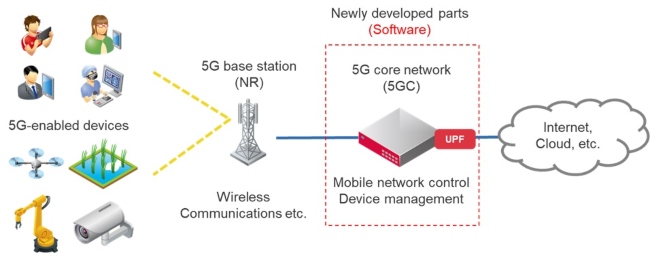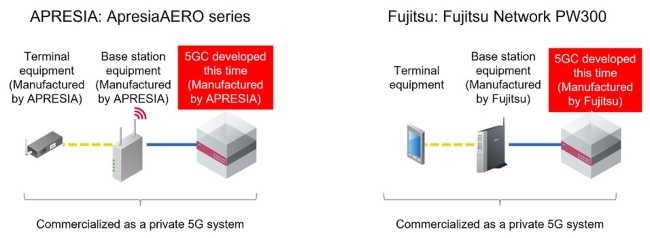
TOKYO, Nov 24, 2022 - (JCN Newswire) - The University of Tokyo, Internet Initiative Japan (IIJ), APRESIA, and Fujitsu Limited have successfully developed Open Source Software for the Private 5G/6G Mobile System, realizing a domestically produced, low-cost 5G core network (5GC), the core technology of the 5G mobile network. The initiative was conducted by the partners as part of NEDO's Research and Development Project of the Enhanced Infrastructures for Post-5G Information and Communication Systems Feasibility Study (Contracted).
 |
| Figure 1: Image of the Newly Developed 5GC |
 |
| Figure 2: Image of Private 5G System Commercialized by APRESIA and Fujitsu |
 |
| Figure 3: Image of Multiple Private 5G Systems Promoted by IIJ |
5GC software plays a central role in controlling cell phone networks, but the need for domestic production and cost reduction represents ongoing challenges to making related technologies, like private 5G, a reality. With the development of this new technology, IIJ, APRESIA, and Fujitsu developed a practical version of 5GC based on Open Source Software with commercial-level functionality, performance, and stability based on Open Source Software. The University of Tokyo contributed a user plane function (UPF) that handles more advanced data transfer and route selection by combining 5GC with previously known properties and have applied for a new patent.
The partners anticipate that the eventual, real-world deployment of this technology will allow users to introduce private 5G systems at lower cost for use in practical settings, leading to the wider adoption of private 5G in various industries. Combining multiple private 5G networks and 5G services provided by major telecommunications carriers will ultimately make it possible to deliver more versatile communication environments than individual private 5G networks alone.
1. Overview
5G cell phone networks are beginning to be used not only as a means of communication, as is the case for phones and smartphones, but also in critical infrastructure systems that support society, such as payments and logistics. Although the technology that makes up mobile networks is based on a common global standard, most of the communications equipment used in actual mobile networks is manufactured by vendors outside of Japan, which also hold many of the patents for intellectual property for related technologies. This represents a possible risk to market competition and economic security, making it an important priority for Japanese companies and researchers to proactively develop products and technologies in anticipation of post-5G and next-generation communication standards that are expected to emerge after 2025. Going forward, it is hoped that industry-academia-government collaboration will lead to the development of practical-level communication devices and the resolution of issues.
Against this backdrop, in Japan, NEDO has conducted its "Research and Development Project of the Enhanced Infrastructures for Post-5G Information and Communication Systems (1) /Feasibility Study (Contracted)" surrounding the theme of "Open-source software development for Local5G/6G mobile systems." The initiative, which lasted two years from October 2020 to October 2022, resulted in the successful development of core technology by the partners for 5G mobile network technology that can be domestically produced at low cost.
2. Key outcomes of this project
Development of 5G Core network (2)
Unlike 5GC for major telecommunications carriers, which is designed to manage tens of millions of lines, the 5GC developed through this project is a compact implementation that can efficiently manage several to several thousand lines. Development based on Open Source Software (3) has also decreased the burden of intellectual property costs. This makes it suitable for environments where many small-scale 5G systems, such as private 5G, are to be built. Because it is implemented as software that runs on Commercial Off-The-Shelf (COTS), 5GC can also be cloud-based for maximum utilization.
Open and closed strategies
The 5GC developed in this project is based on free5GC, which is being developed by engineers around the world as Open Source Software. In general, Open Source Software is superior in terms of transparency because all source code is publicly available, so it is possible to check for the inclusion of programs with malicious intentions. On the other hand, some Open Source Software lack the necessary functions for commercial use, and there are technical issues such as insufficient verification of performance and stability.
In this project, based on the knowledge of IIJ, which operates commercial networks, the partners added functions to free5GC, improved its performance, and verified its stability using technology from APRESIA and Fujitsu, which develop many commercial network products, and raised its quality to a level where it can be used as a commercial product. The ability for Japanese companies to provide highly practical 5GC with transparency is also important from the perspective of economic security.
This project newly defines the open and closed strategy, establishing collaborative areas in which the results of development are returned to society (open) and competitive areas that are occupied (closed) to maintain an advantageous position in the market environment. As an outcome belonging to the collaborative area, the free5GC improvement areas implemented within the project are being fed back to the free5GC development team, and the outcomes are available worldwide. In this manner, the presence of Japanese companies in an open development environment is significant not only in the post-5G era, but also in taking the initiative for next-generation communication standards. For results in the competitive area, the partners applied for patents for the university's latest findings to help raise the level of Japan's industrial competitiveness, acquire intellectual property to compete in the global marketplace, and contribute to the revitalization of the economy. They are also paving the way for business models that transfer technology from universities to venture companies.
3. Future plans
APRESIA and Fujitsu will continuously release solutions for private 5G networks that combine the 5GC technology developed through this project and 5G base stations and terminal equipment manufactured by each company. IIJ will also promote the development of communication services that can use multiple private 5G networks using 5GC developed through this project and public 5G networks provided by IIJ as a mobile virtual network operator (MVNO) through roaming. Furthermore, the University of Tokyo plans to supply the results of this development to an integrated private 5G system of a university-launched venture company.
Going forward, the University of Tokyo will work together with companies to further promote industry-academic collaborations around the research of solutions and services that utilize the 5GC technology developed in this project, as well as conduct R&D on open base station equipment (NR: New Radio) that operates on the public cloud to accelerate efforts to further advance cloud-native 5G cell phone network technologies.
(1) Research and Development Project of the Enhanced Infrastructures for Post-5G Information and Communication Systems :
Project name: Research and Development Project of the Enhanced Infrastructures for Post-5G Information and Communication Systems
Project period: From FY2019
Project summary: www.nedo.go.jp/activities/ZZJP_100172.html (in Japanease)
(2) 5G core network:
Post-5G core networks will require advanced technologies related to virtualization and computational resource management in order to efficiently process huge amounts of traffic with the least possible power consumption and at the lowest possible cost, while meeting the requirements of diverse services. Moreover, in order to meet the demand for low latency and high reliability, we may see a significant shift from processing in single huge data centers to cloud-based core networks that utilize multiple geographically dispersed computing resources in the future.
(3) Open Source Software:
The source code is open to the public and can be used, modified, and redistributed for either commercial or non-commercial use, and is actively being adopted by companies for commercial products and services, especially for general-purpose libraries.
About Fujitsu
Fujitsu's purpose is to make the world more sustainable by building trust in society through innovation. As the digital transformation partner of choice for customers in over 100 countries, our 124,000 employees work to resolve some of the greatest challenges facing humanity. Our range of services and solutions draw on five key technologies: Computing, Networks, AI, Data & Security, and Converging Technologies, which we bring together to deliver sustainability transformation. Fujitsu Limited (TSE:6702) reported consolidated revenues of 3.6 trillion yen (US$32 billion) for the fiscal year ended March 31, 2022 and remains the top digital services company in Japan by market share. Find out more: www.fujitsu.com.
Source: Fujitsu Ltd
Copyright 2022 JCN Newswire . All rights reserved.














